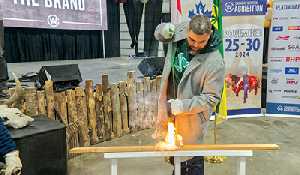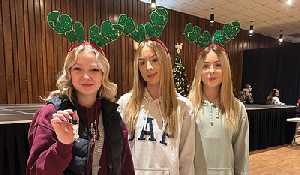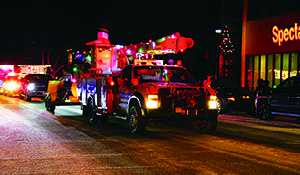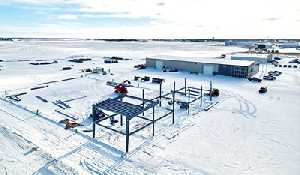Moosomin’s Cenotaph a one-of-a-kind monument
What do Cararra, Italy, the city of Florence, and sculptor Sergio Vatteroni have to do with Moosomin?
July 1, 2020, 8:11 am
Kevin Weedmark


If you walk or drive by it every day, you probably don’t pay much attention to Moosomin’s Cenotaph, at the center of a small park at Broadway and Carlton Street.
You might pay attention to the cenotaph at Remembrance Day, and you may have noticed when Clay and Amy Leduc fixed up the cast iron fence around the cenotaph last year, lovingly restoring the cast iron, painting the fence black and the decorative poppies red.
But you may have never given much thought to the Cenotaph itself.
You may have noticed in passing that many communities have a cenotaph consisting of a block or cross of granite inscribed with soldiers’ names, or perhaps with a marble statue of a soldier.
If you’re very observant, you may have noticed that those marble statues are very worn after a century in the Prairie elements, while the sculpture on Moosomin’s cenotaph doesn’t look much different than the day it was unveiled in 1924.
It perhaps never crossed your mind how rare it is to see a cenotaph like Moosomin’s, topped with a bronze sculpture of a soldier, an undertaking that was much more expensive than marble or granite.
As a matter of fact, there are only a handful of bronze statues across Canada that are part of war memorials.
And you probably had absolutely no idea that the bronze sculpture atop Moosomin’s Cenotaph was designed for Moosomin by a well-known Italian sculptor, Sergio Vatteroni, whose bronze works are scattered across the world, and include “Gandhi and Goat,” a famous statue of Mahatma Gandhi in Delhi.

And you almost certainly didn’t know that after Vatteroni designed the sculpture for Moosomin at his studio in Cararra, Italy, it was cast in bronze in Florence, before being shipped to Moosomin via New York and Montreal.
Planning for the cenotaph
Moosomin’s Cenotaph was constructed in 1924 and dedicated to the memory of those in the Moosomin and District who died in the Great War 1914-1918.
Later, names were added commemorating those who died in the Second World War and the Korean War.
The first mention in the World-Spectator of a fund for a war memorial was in the fall of 1919. According to the newspaper report, those present were in favour of an early start on a vigorous drive to raise $4,000. However, more conservative citizens felt that the coming vote on a Union Hospital District was so important that the fund drive should not be held until after the vote. There were delays in the hospital vote. There were those who felt that holding off the monument drive would make the objective harder to reach, suggesting that already, people were beginning to forget the war.
Early in 1923, an advertisement was published asking sculptors and marble firms to present sketches and layouts.
There were 12 submissions and the committee decided on a stone monument bearing the names of those who died in the war, and a bronze statue of a First World War soldier on top.
The successful bidder on the project was Quinn & Simpson, marble and granite dealers, of Portage la Prairie. They offered a design within the budget of $4,000.
The company ran into one problem when they saw the list of names of those who perished in the war from Moosomin. It contained the names of more than 60 soldiers. From their experience with towns of similar size, the stoneworkers expected a list about half that long. This meant the main stone had to be larger and it took weeks to find the right stone that was big enough.
The Portage company had established links with artists and craftsmen in Italy, who produced bronze figures for war memorials. The order for the Moosomin statue was placed in June, 1923.
On September 10th, that plaster model of the Moosomin statue, made in Carrara, was transported to the foundry in Florence.
The statue was shipped to New York on the steamship “Colombo” then to Montreal and then to Moosomin.

Choosing a location
Plans had been made to unveil the new memorial on November 11th, 1923, but shipping delays meant the ceremony was delayed until the summer of 1924.
On June 27th, 1923, the World-Spectator reported: “At a well-attended meeting of the Memorial Committee, the corner of Broadway and Carleton was selected as a site for a monument to be erected in the memory of Moosomin’s heroic dead. Messrs. McCurdy, McDonald, Downing, Page and Truscott were nominated to erect the memorial and to select the names to appear on the stone. The monument, with a bronze figure, is likely to cost four thousand dollars. The gentlemen in charge will have a dozen designs to choose from.”
The site was a slough at the time.
The Government of Saskatchewan provided an engineer to determine the levels and grades, and to oversee the filling and cribbing. The provincial government also provided blueprints of plantings for the park. The plan was to provide a high, thick background, and to block the view of any buildings behind the Cenotaph.
On May 6th, 1924 the local committee wrote to Quinn and Simpson:
“Replying to your letter of the 29th, the committee, having considered this matter, has decided that they do not wish to change the stone selected, and would rather delay the matter a while longer to await a suitable stone.”
On June 23, 1924, Quinn and Simpson replied:
“We received a letter a few days ago from the quarry in regard to the Memorial die, but have been expecting further word every day advising us that the piece is alright. Their letter of June 3rd says that the big die just got to the station, and they will be right at it.”
On August 20th, 1924, the World-Spectator reported that the site of the Memorial Park had been cleaned up thanks to the help of volunteers. “The monument is expected this week.”
Unveiling
Saskatchewan’s acting Lieutenant-governor, Frederick Haultain, and two Victoria Cross winners were at the unveiling of the Moosomin War Memorial on August 31, 1924—Haultain’s aide-de-campe was a Victoria Cross winner, as was Moosomin’s Harry Mullin.
The Moosomin Band provided the music, and the bugler was William Woodhead of Wapella.
The World-Spectator reported that “the ceremony of unveiling was carried through with a dignified solemnity which will not soon be forgotten by the immense throng present. The ceremony of unveiling was performed by the Hon. Sir Frederick Haultain, Acting Lieutenant-Governor, who was accompanied by his aide-de-camp, Major Allard; V.C. Mayor McCurdy was chairman. The Guard of Honour, comprising 100 ex-servicemen from the area, was under the command of another Victoria Cross winner, Harry Mullin, native son of Moosomin.

“In his address to the assembly, Sir Frederick pointed out that, while in Great Britain, they had erected a Cenotaph and paid homage to the Unknown Soldier. Here, in Moosomin, is unveiled a memorial to the known dead, personally dear to all of us.
“This splendid monument,” he said, “shows the sentiment of the people of the town and district. It is a fitting memorial to those who lost their lives in the Great War, whose bodies now lie in the fields of France and Flanders. They had gone to battle because they loved their country, and right well they played their part.
“These men, whose names are being commemorated today, were among the gallant soldiers of this Dominion who had made the name of Canada a revered one in France and Belgium.”
“The monument is now complete,” said Mayor McCurdy, “and it is planned to make this spot beautiful with trees, flowers and green grass, not as a pleasure ground but as a spot where one may pause in quiet contemplation on this enduring monument to remind all of service and sacrifice. I would like to say to the young people that, in the years to come when, in the natural course, you take over the duties and responsibilities of your parents, you will see that this plot of ground is kept ever green and garnished, and that this emblem of sacrifice is lovingly treated.” Tweet



































